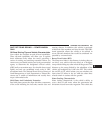
no more than a
1
⁄
4
turn quickly back and forth, while
still applying throttle. This will allow the tires to get a
fresh ЉbiteЉ and help maintain your momentum.
CAUTION!
On icy or slippery roads, do not downshift at high
engine RPMs or vehicle speeds because engine brak-
ing may cause skidding and loss of control.
•
Mud – Deep mud creates a great deal of suction
around the tires and is very difficult to get through.
You should use 4L (Low Range) with a gear low
enough to maintain your momentum without shifting.
If you start to slow to a stop, try turning your steering
wheel no more than a
1
⁄
4
turn quickly back and forth
for additional traction. Mud holes pose an increased
threat of vehicle damage and getting stuck. They are
normally full of debris from previous vehicles getting
stuck. As a good practice before entering any mud
hole, get out and determine how deep it is, if there are
any hidden obstacles and if the vehicle can be safely
recovered if stuck.
•
Sand – Soft sand is very difficult to travel through
with full tire pressure. When crossing soft sandy spots
in a trail maintain your vehicle’s momentum and do
not stop. The key to driving in soft sand using the
appropriate tire pressure, accelerating slowly, avoid-
ing abrupt maneuvers and maintaining the vehicle’s
momentum. If you are going to be driving on large soft
sandy areas or dunes, reduce your tire pressure to a
minimum of 15 psi (103 kPa) to allow for a greater tire
surface area. Reduced tire pressure will drastically
improve your traction and handling, while driving on
the soft sand, but you must return the tires to normal
air pressure before driving on pavement or other hard
surfaces. Be sure you have a way to air the tires back
up prior to reducing the pressure.
346 STARTING AND OPERATING


















